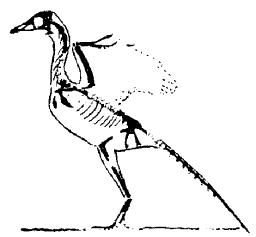 |
Science Frontiers ONLINE No. 48: Nov-Dec 1986 |
|
|
Archaeopteryx a dead end?
"Just as the 150-million-year-old Archaeopteryx fossil is being reinstated as the earliest known bird after considerable controversy, along come two crowsize skeletons that are not only 75 million years older than Archaeopteryx but also more birdlike, according to the paleontologists who discovered them. The Washington, D.C.-based National Geographic Society, which funded the work, announced this week that Sankar Chatterjee and his colleagues at Texas Tech University in Lubbock found the 225-million-year-old fossils near Post, Tex."
(Weisburd, S.; "Oldest Bird and Longest Dinosaur," Science News, 130:103, 1986.)
Chatterjee has named the new fossil Protoavis.
"Protoavis seems certain to reopen the long-running controversy on the evolution of birds. In particular whether the common ancestor of birds and dinosaurs was itself a dinosaur. Protoavis, from the late Triassic, appears at the time of the earliest dinosaurs, and if the identification is upheld it seems likely that it will be used to argue against the view of John Ostrom of Yale University that birds are descended from the dinosaurs. It also tends to confirm what many paleontologists have long suspected, that Archaeopteryx is not on the direct line to modern birds. It is in some ways more reptilian than Protoavis, and the period between the late Jurassic Archaeopteryx and the world-wide radiation of birds in the Cretaceous has to some seemed suspiciously brief."
(Anonymous; "Fossil Bird Shakes Evolutionary Hypotheses," Nature, 322:677, 1986.)
Comment. But what about all those textbooks that assure us positively that birds descended from dinosaurs and that Archaeopteryx is a classic missing link?
 | Fossil bones and artist's reconstruction of Protoavis. |